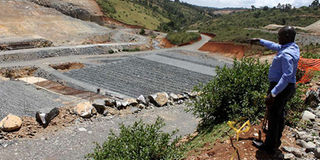Italian firm in dams scandal battles bankruptcy

This photo taken on February 25, 2019 shows the site in Nakuru where Itare dam is to be constructed by CMC di ravenna. The project has stalled. PHOTO | JOHN NJOROGE | NATION MEDIA GROUP
What you need to know:
- The troubled CMC di Ravenna reflects problems facing the construction industry in Italy. Six top Italian builders are currently either going through insolvency or negotiating with creditors.
- To avoid defaulting on maturing debts, some of the companies have been signing contracts abroad and seeking quick advance payments.
The Italian firm caught in the web of investigations over the proposed Kimwarer and Arror dams has filed a proposal with an Italian court on how it intends to evade bankruptcy and a run-in with its creditors.
Italian newspapers report that Cooperativa Muratori e Cementisti, one of the companies in the joint multibillion-shilling dams project in Elgeyo-Marakwet County, has deposited its proposals with the Court of Ravenna on its “business continuity” plans and on when to pay its creditors and strategic suppliers.
It is not clear if the settlement plan includes any of the Kenyan suppliers after its subsidiary ran into trouble with banks over loans taken to buy equipment for the yet-to-commence projects in Elgeyo-Marakwet and in the abandoned Itare dam in Nakuru County.
ASSETS SEIZED
Known in Italy as concordato preventivo, this is a court sanctioned agreement that allows struggling companies to try to avoid full bankruptcy by restructuring their debt payments.
Initially, before the enactment of the new insolvency laws, the country’s bankruptcy laws were deemed harsh, with debtors criminalised and not allowed to enter the market either as entrepreneurs or consumers.
While the firm has taken advantage of Italian laws that advocate for corporate reorganisation and restructuring rather than liquidation, its problems in Kenya continue.
Last month, the High Court in Nakuru stopped CMC di Ravenna, the Kenyan subsidiary of the Italian firm, from selling, transferring or interfering with equipment and 98 motor vehicles that were bought with loans advanced by Barclays Bank of Kenya.
DEBT PAYMENT
The bank has since seized the vehicles and equipment, as detectives from the Directorate of Criminal Investigations (DCI) continue to rummage through documents, both in Kenya and abroad, as part of an investigation on the advance payment of Sh21 billion to the firm.
Barclays Bank fears that the Italian firm might move the assets outside Kenya or sell them to settle other debts before honouring its loan obligations.
The troubled CMC di Ravenna reflects problems facing the construction industry in Italy. Six top Italian builders are currently either going through insolvency or negotiating with creditors.
On Tuesday, the largest Italian contractor, Astaldi SpA, announced that it was still going through a “composition procedure” — known in Italy as “concordato in continuità” — the result of foreign ventures gone sour or due to reduced government spending in Italy.
To avoid defaulting on maturing debts, some of the companies have been signing contracts abroad and seeking quick advance payments.
RECESSION
The same cash-flow problem was the reason behind the contractor’s walkout from the Melamchi project in Nepal.
Under article 161 of the Italian Insolvency law, a company in financial crisis can postpone, or salvage, its downfall for several months once it receives the flexibility given by the courts as part of the “business continuity”.
The survival of the Italian construction companies depends on the country’s economy, which is in the doldrums at the moment, having entered a recession in the second half of 2018.
There is also fear of financial turmoil around Italy’s sovereign debt, especially at a time when the country’s public debt is significantly bigger than its economy.
STALLED PROJECT
CMC di Ravenna has been in the spotlight in Kenya over possible loss of public funds amounting to Sh21 billion after it won a contract to build the two Elgeyo-Marakwet dams.
Despite receiving a down payment, work on the dams has not started, triggering an uproar and fear that the financially crippled company had no capacity to finish the project.
The Treasury admits that an advance payment of Sh7.8 billion was made to CMC di ravenna. Of this amount, Sh4.3 billion was released for the Arror dam and Sh3.5 billion for Kimwarer.
The balance was paid to an insurance firm, Sace, as security for the construction of the dams.




